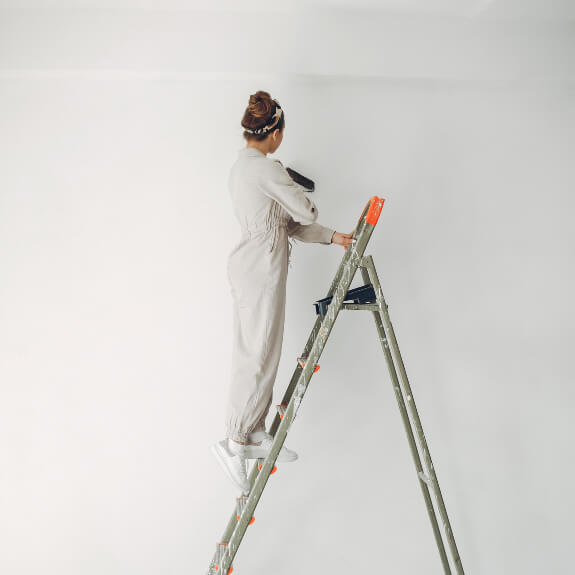How Do You Make A Room Look Bigger With Paint Colors?

When it comes time to refresh a room’s aesthetics, the power of paint colors cannot be understated. Not only can a fresh coat of paint revitalize a space, but it can also create the illusion of more space, which is particularly valuable for smaller rooms. Through the strategic use of color and finish, homeowners can manipulate perception to make a cramped room feel more expansive.
Color has a profound effect on our perception of space. Light hues are renowned for making spaces seem larger and more inviting, while darker colors can create a cozy, albeit more enclosed feeling. It’s not just the color choice that matters, but also where and how it’s applied. Through careful coordination and application, paint can be a practical magician, transforming your room into a seemingly airy abode.
Choose Light and Neutral Colors
The easiest way to give the impression of a larger room is by using light and neutral colors. Lighter tones such as white, cream, or light gray, can reflect more light, which enhances the room’s openness and airiness. But there is more to consider than just slapping on a coat of eggshell white.
The Psychology of Color
Neutral tones serve as the perfect backdrop for any type of furniture and decor, making the room more adaptable to changes in style without the need for a new paint job. They also have a psychological aspect; light colors are often seen as calming and can help to create a peaceful environment, ideal for spaces like bedrooms and living rooms.
The Role of Paint Finish
The finish of the paint plays an integral role as well. Glossier finishes reflect more light, which can help to open up the space even further. However, it’s crucial to ensure your walls are in good condition, as higher gloss finishes can also highlight imperfections. A satin or semi-gloss finish can offer a good balance between reflectivity and ease of maintenance.
Balancing with Accents and Contrast
While neutral walls can make a room seem larger, adding a few accents of color can add depth and character without shrinking the perceived size of the space. Consider using bolder colors for accent walls or within decorative elements, such as brightly colored frames, cushions, or rugs, to add visual interest without overwhelming the space.
Utilize Color Theory and Contrast
Understanding color theory can go a long way in selecting the perfect hues to enhance the spaciousness of a room. Warmer colors tend to advance, while cooler colors recede. Using this knowledge, you can manipulate how close or far away the walls seem.
Cool Hues to Open Up Space
Cool colors, like blues, greens, and lavenders, are often recommended for walls, as they can visually push them back, giving an impression of a more spacious room. To enhance this effect, paint moldings and trim in a lighter color than the walls, which draws the walls back and the trim forward, adding to the illusion of depth.
Illusions with Contrast
Another trick is to play with contrasting colors to create depth and dimension. Painting one wall a slightly darker shade than the others can give the illusion of depth. However, be cautious with dark hues, as an overly dark room can feel smaller and more enclosed.
Strategic Use of Stripes
Horizontal stripes can make a room appear wider, while vertical stripes can make it appear taller. This technique is particularly useful in irregular spaces, such as attic rooms, helping to draw the eye upward or outward and emphasizing the room’s dimensions.
Lighting and Color Interaction
The interplay between lighting and paint color is essential when trying to maximize the perception of space. Different light sources can significantly change how a color looks, and therefore, can affect the room’s spaciousness.
Natural vs. Artificial Light
Maximize natural light wherever possible, as it provides the truest reflection of colors and contributes to an open, airy feel. If the room lacks sufficient natural light, invest in well-placed artificial lighting to mimic natural light and enhance the same effects.
Reflective Surfaces and Strategic Lighting
Incorporating reflective surfaces such as mirrors can also aim light into darker corners, making the room appear larger. Additionally, using directional lighting can highlight certain aspects of the room, distracting from its smaller size.
Daylight Bulbs
Choosing the right type of bulb can make a difference too. Daylight bulbs provide a crisp, white light that can make the room feel more spacious and mimic the light you would get from a window.
Conclusion
Creating an illusion of increased space with paint requires a thoughtful approach to color selection, understanding of visual perception, and strategic lighting. Light and neutral colors tend to open up a space, while cool hues, used in combination with contrast, add depth without enclosing the space. Remember, lighting and reflective surfaces can significantly alter the perceived size of a room, so it’s important to integrate these elements with your paint choices.
At Britton Paint & Exterior, we understand the nuances of making a space feel welcoming and expansive through high-quality painting services. If you reside in or near Dayton, Ohio, we invite you to reach out for a free painting quote. Our team of experts is ready to assist you in selecting the ideal colors and painting techniques to make any room in your home or commercial property look bigger and more inviting.
